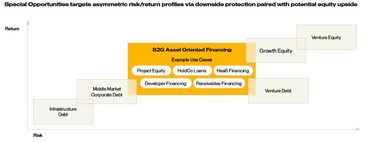
Inside S2G’s Approach to Investing in Hardware-as-a-Service


Since S2G first launched its Special Opportunities strategy in 2022 — designed to back differentiated business models that sit between traditional growth and infrastructure investing but hold the potential to unlock capital efficiency and resilience at scale—HaaS financing models have been a core area of focus.
While HaaS is often associated with conventional equipment finance, S2G’s Special Opportunities team approaches it differently. We offer flexibility on structure and cost of capital to tailor solutions to the realities of each borrower. From an investment perspective, our underwriting emphasizes the durability of lease and offtake cash flows as primary security, rather than relying solely on equipment value, aligning financing with performance outcomes and positioning both borrowers and investors for long-term success.

Since launching the Special Opportunities strategy, S2G has mapped nearly 200 HaaS companies across renewable energy, industrial efficiency, agriculture, and mobility, building a clear view of where HaaS models create durable value, where they fall short, and how capital can be deployed most effectively to accelerate adoption while protecting downside risk.
Our Core HaaS Investment Principles
- We prioritize HaaS businesses with long-term contracts, scalable pipelines, hardware-agnostic models, and creditworthy customers, as we believe these elements provide the foundation for predictable cash flows and strong customer retention.
- We look for models where lease and offtake cash flows can be underwritten as core security, differentiating ourselves from investors who focus primarily on residual equipment value. Our approach allows us to be flexible around structure and cost of capital, tailoring financing to the borrower’s needs and the specific risk/return profile.
- We prioritize borrowers that use off-the-shelf equipment and flexible system architectures, as these approaches make it easier to pivot to best-in-class technologies and preserve serviceability. If an early-stage OEM goes out of business and their collateral is tied to proprietary technology, it can be difficult to find replacement servicers, directly impairing equipment and contract value.
- Conversely, we avoid companies built on short-term subscription agreements, niche or proprietary hardware, unproven technologies, or heavy consumer credit risk exposure, as these factors introduce volatility and limit scalability.
HaaS in Action: Examples from Our Portfolio

Formic is transforming access to automation for small- and mid-sized manufacturers through its Robotics-as-a-Service (RaaS) model. Rather than requiring large upfront CapEx, technical expertise, or ongoing maintenance capabilities, Formic provides a complete solution that includes the equipment, service, software, and technology. This structure removes the risk and complexity traditionally associated with automation, allowing manufacturers to adopt proven robotics solutions quickly and with minimal disruption.
To date, Formic robots have packed and stacked more than 1.2 billion products and delivered over 400,000 hours of production across its active fleet. The company’s team has deployed more than 500 systems across U.S. manufacturing facilities and has seen 180% growth in market demand, reflecting the accelerating adoption of automation among small- and mid-sized manufacturers.

Comfort Connect modernizes the home services contracting industry with an innovative point-of-sale financing platform purpose-built for heating, cooling, plumbing, and backup power upgrades. Its Premier Program® bundles high-efficiency equipment, maintenance, consumables, service, and lease financing into a single offering, providing a “Home Comfort-as-a-Service” model that keeps systems running at peak efficiency.
The company has achieved an over 74% cumulative annual growth rate, underscoring strong customer adoption of the Premier Program®. Today, 34% of its lease portfolio is in heat pumps, more than double the national adoption rate of 15% (U.S. EIA). Comfort Connect has also developed a full point-of-sale platform that positions it as a complete solution for contractors and secured partnerships with leading HVAC OEMs, including Lennox, Fujitsu, and York.
HaaS Investing: Lessons Learned
S2G’s strategy reflects lessons learned from evaluating and structuring HaaS investments across sectors.
Long-Term Contracts Are Essential
Multi-year agreements are the foundation of a bankable HaaS model. They provide the revenue visibility needed to underwrite non-dilutive financing structures and attract institutional capital. Where only short-term pilots are possible, we look for strong retention metrics or clear pathways to renew agreements.
Scale and Hardware-Agnostic Strategies Drive Competitiveness
Hardware-agnostic design and scalable addressable markets are critical to attractive unit economics. Companies using off-the-shelf components can pivot to best-in-class technologies and sustain competitiveness, while those tied to niche hardware often face constrained growth and higher risk.
Credit Quality Is Non-Negotiable
End-customer credit quality directly shapes the risk-return profile of HaaS investments. Strong counterparties, such as municipalities, universities, utilities, and large corporates, are generally more bankable than SMEs with weaker credit profiles. Rigorous credit underwriting is therefore a prerequisite for deployment. Where customer credit quality is insufficient, HaaS models struggle to scale without credit enhancements or other structuring solutions.
Direct Sales Models Provide Greater Control
Experience has shown that direct sales channels typically offer superior control relative to distributor or B2B2C approaches. By eliminating intermediaries, providers maintain stronger alignment with customers, gain better visibility into performance data, and reduce dependency on third parties for revenue realization. In B2B2C structures, mismatched contract tenors — for example, a provider signing three-year agreements while end customers are bound to six-month terms — can expose companies to servicing and revenue risk. In B2B2C models, S2G looks for distribution partners that are highly incentivized to sell the service.
Not All Hardware Companies Require a HaaS Model
Importantly, S2G has learned that not all hardware businesses are suited for HaaS. In some cases, companies can negotiate contracts where CapEx is paid upfront or at production milestones, effectively eliminating the need for a service-based financing structure. Similarly, industries with customers that have large balance sheets and access to low-cost capital may have little incentive to outsource ownership via HaaS.
Financing the Transition
At S2G, we view HaaS as a critical enabler of industrial efficiency and resource resilience. Our experience investing in HaaS companies has shown how these models can drive adoption in underserved markets, expand the universe of bankable assets, and ultimately reshape how capital is deployed across multiple sectors.
We believe there is a clear opportunity here: as demand for flexible financing and sustainable solutions grows, HaaS will continue to scale as a powerful tool for value creation.
We invite companies deploying HaaS models and investors seeking differentiated exposure to this theme to connect with S2G’s Special Opportunities team to explore partnership opportunities.
Learn more about S2G’s approach to HaaS in our report, “From CapEx to OpEx: The Hardware-as-a-Service Opportunity.”



